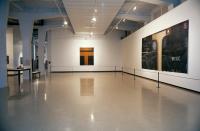Colin McCahon: A View from Urewera
In the late 1960s and the 1970s, New Zealand’s most celebrated modern painter, the Pākehā Colin McCahon, makes a number of works addressing Māori subjects and concerns. One of them, the Urewera Mural (1975), is commissioned by the Urewera National Park Board in 1974 for its Āniwaniw2a Visitor Centre. (Designed by John Scott, the Centre is already under construction.) The Mural is produced in a moment of growing appreciation of Māori land rights, just before the Māori Land March and before the establishment of the Waitangi Tribunal. It is fated—or privileged—to become embroiled in the very politics it seeks to represent.
Urewera is the traditional home of the Tūhoe people, who were not signatories to the Treaty of Waitangi. Due to its geographical isolation, it was one of the last regions to be claimed by the Crown during colonisation in the nineteenth century. McCahon’s triptych asserts Tūhoe sovereignty over the area—he declares it ‘their land’ and name checks Māori prophets Te Kooti and Rua Kenana. However, the Mural's position is complex, as it adorns a Centre that is understood, by some, as a colonial imposition.
Questions have been raised about the cultural appropriateness of McCahon painting Māori subjects. Indeed, when the Mural is first presented to the Park Board for its approval—which it gives—McCahon is famously asked to change four words, for fear they will cause offence to Tūhoe. McCahon replaces ‘Ko Tūtakangāhau te tangata’ (Tūtakangāhau is the man) with ‘Ko Tūhoe te iwi’ (Tūhoe the people). McCahon's ‘mistake’ would be interpreted as cultural ignorance, insensitivity, or presumption. However, the words in question—referring to Tūtakangāhau, a Tūhoe chief—were quoted directly from the Board’s own handbook, which the Board had sent to McCahon to guide him.
For twenty years, the Mural languishes in the remote Visitor Centre with little fuss. But, on 5 June 1997, it becomes news, when Tūhoe activists remove it in the dead of night. It was not theft, they say, when they give it back fifteen months later, but a temporary ‘confiscation’, intended to impress on Pākehā what it is like to be robbed of your taonga. Before the heist, the Mural is the least known of McCahon’s major works; after, it becomes the most famous (or infamous).
After the Mural is returned, it is restored by conservators at Auckland Art Gallery and, in 1999, revealed again to the public. It is shown at Auckland Art Gallery, then at New Plymouth’s Govett-Brewster Art Gallery (with McCahon’s 1972 Parihaka Triptych), then at City Gallery, as the centrepiece Colin McCahon: A View from Urewera. That show includes other McCahon paintings which also feature the T-shaped ‘tau cross’ is a central motif.
In the catalogue, curator Gregory O’Brien writes: '... we follow the rueful logic of McCahon's tau crosses, arrayed across the rest of the country like conductors of some other-worldly electricity or communications system. While the argument of these paintings is as central as the Main Trunk Line to New Zealand's self definition, when we look closely at the geographical co-ordinates of the works in this exhibition, we find they are also a paean to the far flung and the provincial. They assert the centrality of such locales as Muriwai, Ninety Mile Beach, Westland, and, most poignantly of all, the Urewera—for it is on the edge of Tūhoe Country, Te Urewera, that this particular power grid is sourced and where some of the crucial voices in McCahon's art begin their transmission.'
Times change. In 2013, Tūhoe settle their Waitangi Tribunal claims, and gain greater control over Urewera. The area is now administered by the Te Urewera Board with Tūhoe and Crown membership. John Scott’s Visitor Centre, which had fallen into disrepair, has been demolished, despite being lauded as an architectural masterpiece, and McCahon’s Mural is now installed in Te Uru Taumatua, the new Tūhoe cultural centre in Tāneatua.
Curated by Gregory O'Brien
Text extracted from City Gallery Wellington Te Whare Toi website.
Publication on this work can be found through the City Gallery Wellington Te Whare Toi website.




















![[Decorated gourd]](https://www.mccahon.co.nz/sites/all/files/styles/pi_thumbnail/public/images/m001330_0.jpg?itok=4XvcrvgS)